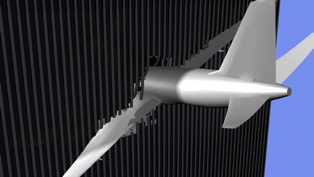
80 hours of high-performance computing produced an engineering analysis of that three-quarters-second that it took an airplane to tear through the World Trade Center north tower.
Although most Americans believe they know what brought down the World Trade Center twin towers on Sept. 11, 2001, civil engineers are still seeking answers to questions that could save lives in the future.
Structural engineers need to know from a scientific perspective what happened to the buildings during the terrorist attacks in order to prevent future failures. The search for answers continues with the help of a state-of-the-art animated visualization created by researchers at Purdue University.
The simulation depicts how a plane tore through several stories of the World Trade Center north tower within a half-second and found that the weight of the fuel acted like a flash flood of flaming liquid, knocking out essential structural columns within the building and removing fireproofing insulation from other support structures.
To develop the new animated visualization, Voicu Popescu, an assistant professor of computer science, developed a translator application that creates a link between computer simulations and computer visualization systems to automatically translate simulation data into a 3-D animation scene.
The animation can be seen online.















Phew!
Watched it a couple of ways. Try it with the sound off. Eerie.
I wish I still had access to the presentation, but a few weeks before 9/11 happened, I was working on a CS team to give a presentation to upper level DOD personal about what would happen if a plane/truck bomb/etc were set off at some specific targets around the world. They included the WTC buildings, the pentagon and the white house along with other military installations throughout the world. Sadly the day of 9/11 the work was canceled and classified. 🙁
HAIL PURDUE!
They are seeking answers that will save lives in the future? Here’s one:
Get BushCo and the neocons out of our government NOW.
My gut feeling is, how is that exercise going to do anything but cost a lot of money? Exactly how is it going to save lives? Are they going to retrofit all tall buildings to survive 747’s?
I’m thinking the Purdue group is simply using the WTC to pump their simulation platform – that seems to be the tone of the video. Obviously 9/11 is loaded baggage so any reporting is going to focus on that instead.
5 & 6 are obviously right. Why should a top-rated engineering school actually want to evaluate existing civil engineering? Much better to rely on little cardboard cutouts developed by the rest of our education system.
Are they going to retrofit all tall buildings to survive 747’s?
Probably not, but they might use the knowledge gained to design more resistant new buildings.
#7, #8, The cause was so extreme that any knowledge gleened from a simulation would be as useful as how to protect a car from a 80 ton asteroid. Time and money at Purdue could be better spent on more common problems like earthquake protection, quisk escape solutions, energy efficiency.
This is clearly a story that will never die, because people seem to not be able to understand that the building was built to collapse the way it did for when the building needed to be torn down. The theory was that it was too big to take a part, and there were too many buildings around it to use the amount of explosives required if it wasn’t built in such a way.
10. Hey, so now we dont have to use those pesky demolition experts, just decommisioned airliners. Think of the money you’ll save in Vegas.
What I don’t understand is where are the bundles of explosives that the CIA secretly attached to the columns to bring down the building. After all, we know that steel and concrete can’t burn, right Rosie?
12. They blowed up, mebee? Your question makes little sense.
#9, Any information that will add to our knowledge of engineering and materials should be welcomed. So often the things learned in one application are transferable to another application. High rise fires are a serious problem, whether caused by terrorism or through an unforeseen incident, and much more common then are earthquakes to almost the entire US.
#12, Under the right conditions, both concrete and steel can burn. Usually though, as in this case, prolonged high temperatures can cause concrete to crumble and steel to soften and lose structural integrity.
#13 and #14 – Guys… #12 knows that steel can burn. He was making fun of Rosie O’Donnel who made herself sound like an idiot (again) and gave liberals a bad name (again) on that show for bored housewives.
I couldn’t find one piece of new information? If its there, what was it?
99% of what is said was said in that tv special “Anatomy of a Collapse” or whatever that pretty much shows what happend with excellent animation.
Do we want to design buildings to withstand impact from a fully gas loaded 747? Sure if it can be done economically. I wonder how much flame resistent steel (sic) would cost to develop?
#15 – Rosie didn’t make herself sound like an idiot – she exposed herself as an idiot. 😉
#15,
If a joke has to be explained then it wasn’t very funny.
But then, what show for bored housewives?
nice animation… i’d like to see one that explains building 7.
it fell too neatly for my tastes…
-s
The obvious solution for resistance against 747s: go DOWN instead of up, and build the whole damn skyscraper underground. Guess that would then be called a groundscraper?
#11 – Brilliant!
#11 As much as vegas would -love- the spectacle of that, I don’t think that flying remote controlled airplanes into buildings is going to be acceptable any time soon. Not the least for what it would bring to mind, but because it might not work, and that would be really bad PR all around.